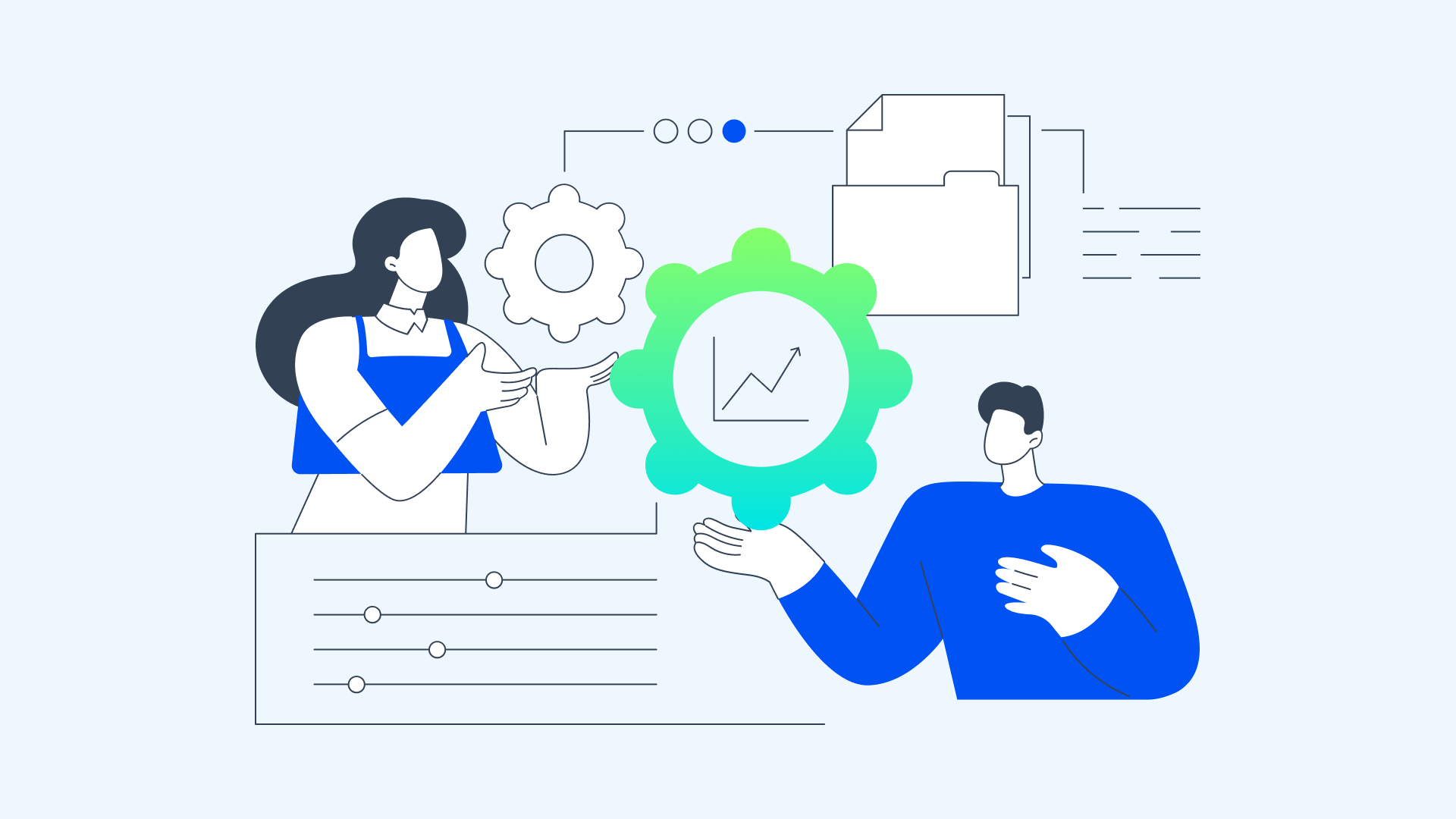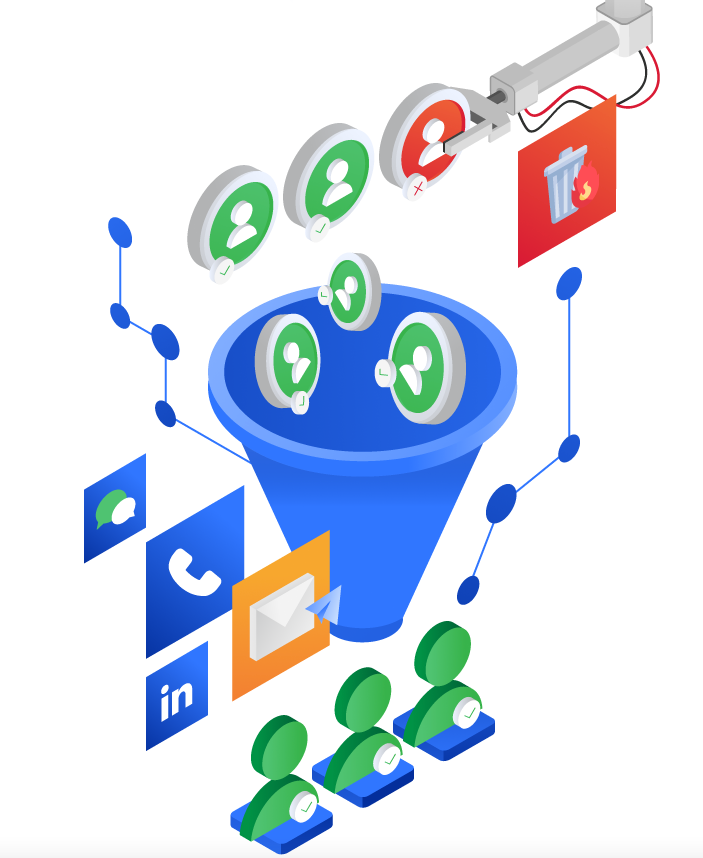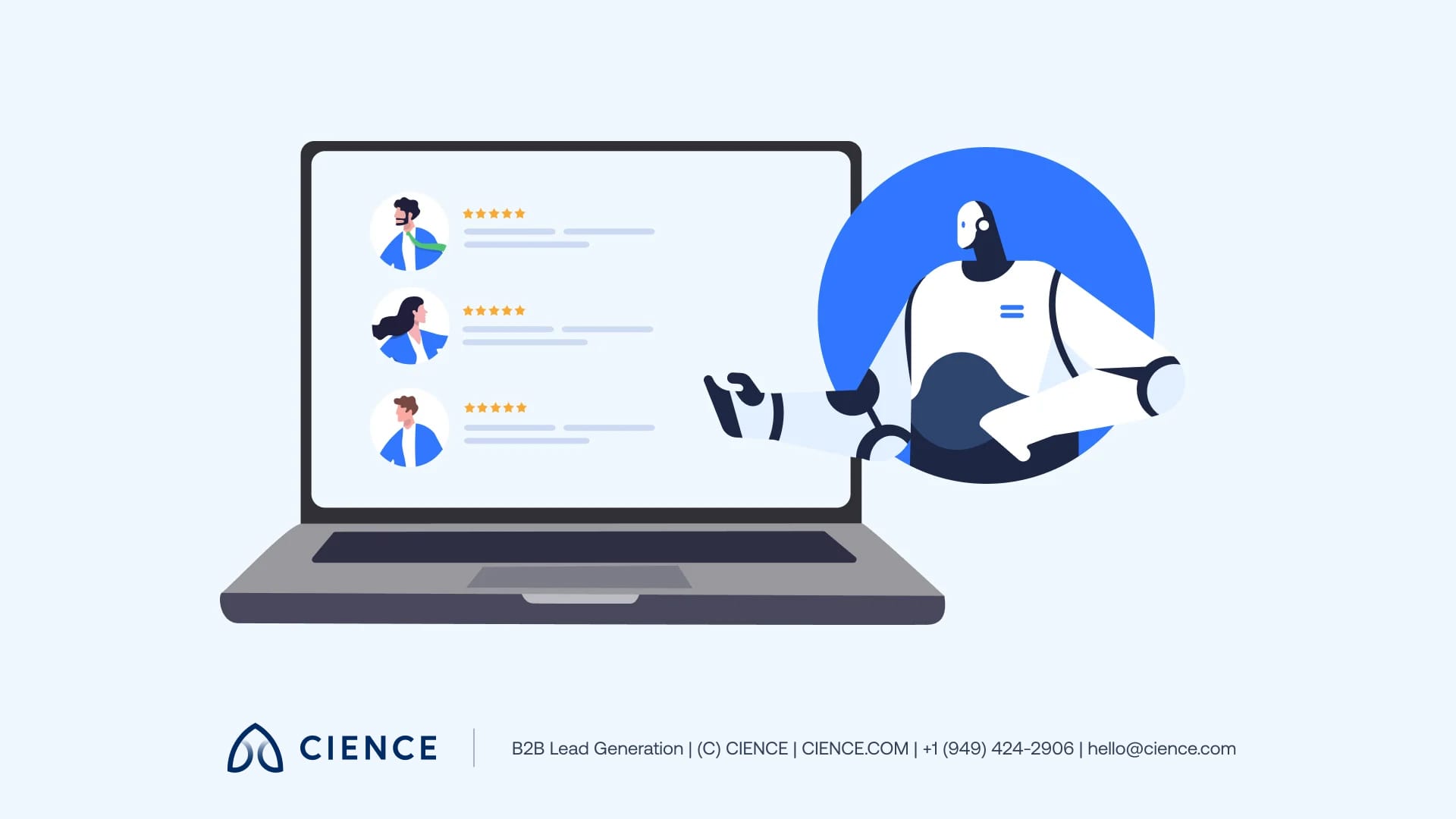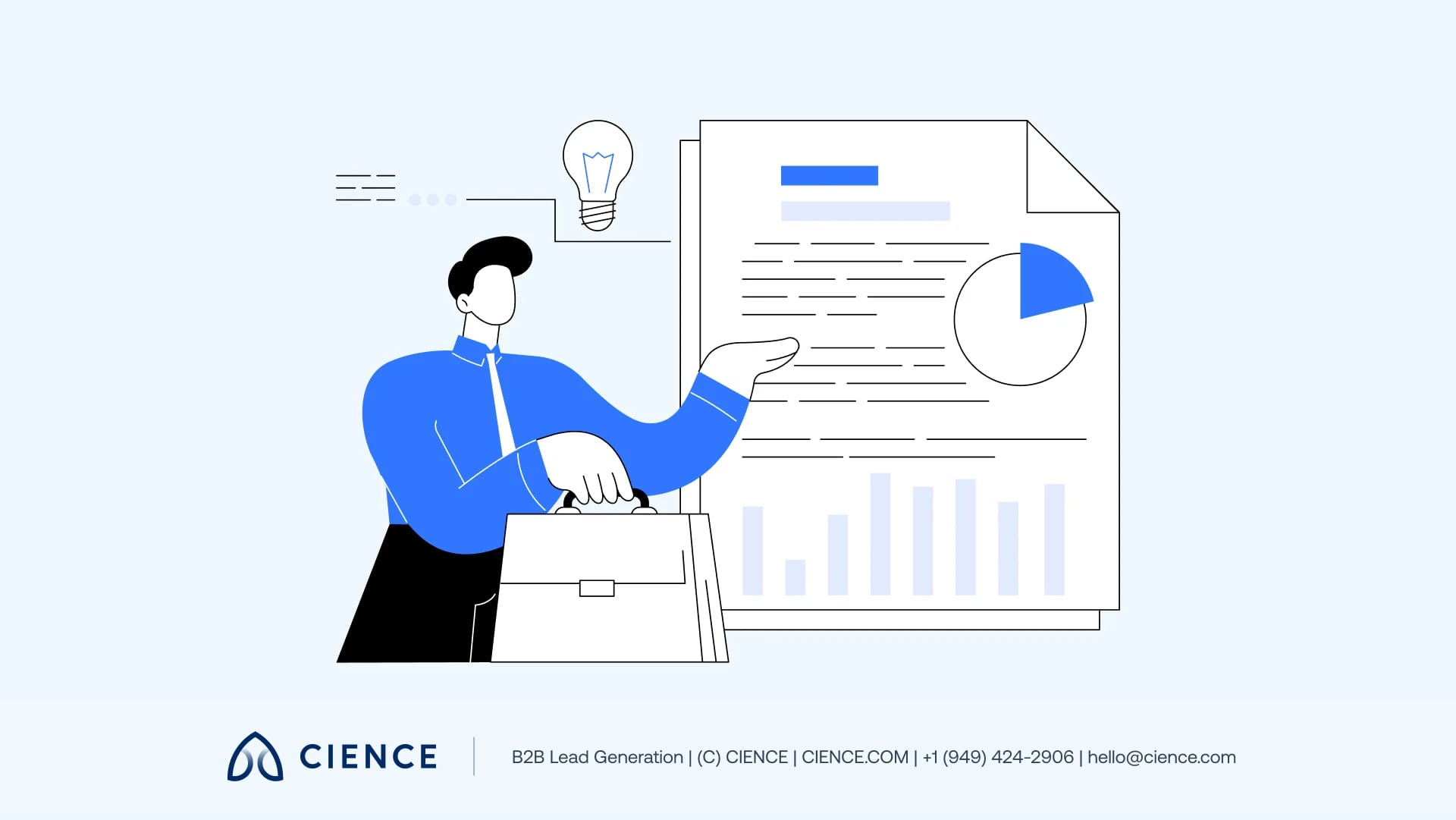B2B Lead Generation 101: Proven Strategies, Tools & Process Revealed
The importance of B2B lead generation cannot be overstated—it's the lifeblood of any thriving business. In 2024, businesses that prioritize lead generation report an astonishing 133% increase in revenue compared to those that don't. Moreover, companies that excel in lead nurturing generate 50% more sales-ready leads at a 33% lower cost. These statistics are not just numbers; they are a testament to the transformative power of effective lead generation.
Today's business landscape is fraught with challenges: consumer spending is unpredictable, inflation is rising, and the job market is in constant flux. B2B sales cycles are lengthening, and companies are grappling with how to navigate an uncertain future. Yet, amidst these uncertainties, one truth remains unwavering—B2B lead generation is more critical than ever before.
Our guide simplifies B2B lead generation, turning complexity into clarity. Ready to lead?
Let's get started! 🚀
What Is B2B Lead Generation?
B2B lead generation is the process of identifying, attracting, and engaging potential customers or clients for a business's products or services. It involves various marketing and sales activities, such as email marketing, social media campaigns, and multichannel outbound efforts, that aim to generate interest in the product, capture contact information, and ultimately convert prospects into paying customers.
In contrast to B2C lead generation, which often focuses on generating high volumes of leads, B2B lead generation prioritizes quality over quantity. Generating leads that fit the ideal customer profile (ICP) and have a high likelihood of converting into paying customers is essential. This requires a more personalized and relationship-oriented approach, building trust and credibility over time.
Understanding these distinctions will supercharge your lead generation success. Let's explore the unique dynamics of B2B and B2C lead generation.
B2B vs. B2C Lead Generation

What are B2B Leads? 4 Main Types
B2B leads, or business-to-business leads, are potential clients or companies that may be interested in your products or services. These leads are vital for businesses focused on selling to other businesses, rather than individual consumers. Identifying and nurturing these leads is crucial for driving sales and fostering long-term business relationships.
Identifying and Developing Leads
Before exploring the main types of B2B leads, it's crucial to identify and develop a list of leads based on your ICP. This step ensures your lead generation efforts focus on the right prospects from the start.
- Define Your ICP: Outline the characteristics of your ideal customers, such as company size, industry, and location.
- Build a Lead List: Use your ICP to target leads through strategies like account-based marketing (ABM).
Proper mapping and segmentation during this phase ensure your marketing and sales efforts are directed towards the most promising prospects.
Types of B2B Leads
Once you have developed a list of leads based on your ICP, categorize them into four main types. Each type represents a different stage of engagement and interest in your product or service throughout the prospecting and lead-qualifying process:
| Type of B2B Lead | Key Features | Examples |
| Marketing Qualified Lead (MQL) | Lead showing interest through marketing efforts but not yet ready for direct sales engagement. | - Frequently visits specific webpages - Downloads gated content - Registers for webinars or events |
| Sales Qualified Lead (SQL) | Lead that has moved further down the funnel and is ready for direct sales contact. | - Requests detailed information - Asks for product demos - Shows buying intent in communications |
| Product Qualified Lead (PQL) | Lead that has used your product through a trial or freemium model and shown purchase intent. | - Extensively uses free trial features - Asks about premium features - Provides positive usage feedback |
| Service Qualified Lead (SvQL) | Existing customer interested in upgrading or purchasing additional services. | - Inquires about service enhancements - Provides feedback for advanced features - Demonstrates increased usage of current services |
How to Generate B2B Leads? 5-Step Process with Tips
The B2B lead generation process is a systematic approach to attract, engage, and convert business clients. This process involves several strategic steps, tailored specifically to B2B environments where the sales cycles are longer and relationships are crucial.

Step 1: Define Your Target Customer
Identify the most promising prospects based on specific characteristics. A clear, detailed ICP that directs your lead generation efforts toward the most relevant prospects.
Research and Analysis:
- Analyze your existing customer base to identify common traits.
- Use demographic, firmographic, and technographic data to create a detailed ICP.
- Key attributes include company size, industry, location, decision-making roles, and technology usage.
Segmentation:
- Divide your market into segments that fit your ICP.
- Develop targeted marketing strategies for each segment.
Expert Tip: Use a Customer Data Platform (CDP) to unify data from various sources. This creates a detailed and accurate ICP by combining demographic, firmographic, and behavioral data, enabling precise targeting and segmentation.
Step 2: Develop a Multi-Channel Lead Generation Strategy
Utilize various channels to reach and attract your target audience. A comprehensive strategy that leverages both inbound and outbound channels to maximize reach and engagement.
Inbound Marketing:
- Content Marketing: Produce high-quality content like blogs, whitepapers, and case studies that address the pain points of your ICP.
- SEO: Optimize your website to improve visibility and attract organic traffic from search engines.
- Social Media: Engage with potential leads on platforms like LinkedIn, where B2B interactions are prevalent.
Outbound Marketing:
- Email Campaigns: Send personalized emails to prospects identified through your ICP.
- Cold Calling: Reach out directly to decision-makers within target companies.
- Paid Advertising: Use PPC campaigns to target your ICP on search engines and social media platforms.
Expert Tip: Focus on high-value accounts with an ABM strategy. Personalize marketing messages for specific targets to boost engagement and conversion rates significantly.
Step 3: Engage and Qualify Leads
Interact with potential leads and determine their readiness to move through the sales funnel. A prioritized list of high-quality leads that are more likely to convert, ensuring efficient use of sales resources.
Engagement:
- Use personalized content and outreach efforts to engage leads.
Host webinars, virtual events, and live demos to showcase your product’s value.
Lead Scoring:
- Implement a lead scoring system to rank leads based on their engagement and fit with your ICP.
- Focus your sales efforts on the highest-scoring leads.
Qualification:
- Identify leads in different stages of the buying process: awareness, consideration, and decision.
- Tailor your approach based on the lead’s stage to provide the right information and support.
Expert Tip: Use predictive analytics in lead scoring to identify leads most likely to convert. Analyze historical data to prioritize sales efforts effectively.

Step 4: Nurture and Convert
Build relationships with your leads to guide them towards making a purchase. Stronger relationships with leads and a higher conversion rate as they move through the sales funnel.
Lead Nurturing:
- Develop email drip campaigns that provide valuable content over time.
- Use CRM tools to manage and automate lead nurturing efforts.
Sales Conversion:
- Schedule personalized follow-ups and meetings.
- Offer free trials, demos, or consultations to help leads experience your product or service.
Expert Tip: Automate drip campaigns to deliver personalized content based on lead behavior and buying stage. Use marketing automation tools to nurture leads with relevant information, enhancing engagement and conversion rates.
Step 5: Measure and Optimize
Continuously improve your lead generation process based on performance data. A data-driven approach that continuously enhances the lead generation process, driving better results over time.
Performance Metrics:
- Track key metrics such as conversion rates, cost per lead, and lead quality.
- Analyze which channels and strategies are most effective.
Optimization:
- Refine your ICP and lead scoring models based on data insights.
- Adjust your marketing and sales strategies to improve efficiency and effectiveness.
Expert Tip: Regularly A/B test your emails, landing pages, and CTAs to find what works best. Use these insights to refine and improve your lead generation strategies for better performance and higher conversion rates.
By following this structured approach, you can streamline your B2B lead generation process, ensuring that you attract, engage, and convert the most promising leads efficiently.
10 Tested B2B Lead Generation Strategies to Succeed in 2024

#1 Multi-Channel Approach
Employ a multi-channel approach to maximize reach and engagement. Combining inbound and outbound strategies allows you to connect with prospects at various touchpoints, enhancing your lead generation efforts.
Inbound Marketing:
Content Marketing: High-quality content is king in B2B marketing. According to the CMI, 91% of B2B marketers use content marketing to reach customers, with 61% considering it an effective strategy.SEO: Optimize your website to rank higher on search engines. B2B companies that use SEO see a 14.6% conversion rate, compared to only 1.7% from traditional outbound methods .Social Media: LinkedIn remains a powerhouse for B2B lead generation, with 89% of B2B marketers using it for lead generation.
Outbound Marketing:
Email Campaigns: Companies that use segmented email campaigns note a 760% increase in revenue.Cold Calling: Despite being considered old-fashioned, cold calling is still effective, especially when combined with other strategies. Research from Rain Group indicates that 57% of C-level buyers prefer to be contacted by phone.Paid Advertising: Invest in PPC campaigns to target your ICP on platforms like Google and LinkedIn. According to WordStream, the average conversion rate for Google Ads in B2B is 3.75%, making it a viable channel for generating leads.
#2 Leveraging Technology and Automation
Utilize advanced technologies like AI and predictive analytics to enhance your B2B lead generation process. Predictive analytics can improve lead scoring by identifying patterns that indicate a lead’s readiness to buy.
According to Salesforce, businesses that use AI for lead scoring see a 20% increase in sales opportunities.
At CIENCE, we don’t just follow trends; we set them by leveraging AI-powered lead gen technology to continuously refine our lead scoring models. This approach ensures our strategies remain dynamic and responsive to evolving market conditions.
💡 Explore: Top AI Lead Generation Tools
#3 Account-Based Marketing (ABM)
Focus on high-value accounts using an ABM strategy. Personalize your marketing messages and campaigns for specific target accounts to significantly increase engagement and conversion rates.
ABM allows you to tailor your approach to individual prospects, providing them with customized solutions. Companies using ABM report an 87% higher ROI compared to other marketing strategies.
#4 Continuous Improvement through A/B Testing
Regularly perform A/B testing on your emails, landing pages, and CTAs to determine what works best. Use these insights to continuously refine and improve your lead generation strategies.
Companies that implement A/B testing can see conversion rate improvements of up to 49%. Testing different elements helps identify the most effective approaches, leading to better performance and higher conversion rates.
Example: Dropbox conducted A/B tests on their landing pages and email campaigns, which helped them identify the best-performing versions and resulted in a 60% increase in sign-ups.
#5 Enhanced Content Distribution
Utilize content syndication to broaden your reach and attract high-quality leads by publishing your content on third-party platforms. Syndicating high-value content such as whitepapers, case studies, and research reports across industry-specific websites can significantly boost your visibility and attract leads who are genuinely interested in your offerings.
According to DemandGen Report, 65% of B2B buyers say vendor content had a significant impact on their purchasing decision.
#6 Intelligent Visitor Identification
Implement website visitor tracking tools to recognize anonymous visitors and capture potential leads directly from your website traffic. These tools help convert anonymous visitors into identified leads, providing insights into their behavior and interests, allowing for targeted follow-ups.
CIENCE leverages intelligent visitor identification software to transform anonymous website visitors into actionable leads. This advanced technology captures detailed insights about site visitors, allowing for highly personalized follow-ups and targeted marketing efforts.
Using our intelligent visitor identification software, CIENCE converted 25% of anonymous website visitors into qualified leads. This approach not only increased our lead pool but also enhanced the precision and relevance of our outreach campaigns.
#7 Leveraging Intent Data to Understand Visitor Behaviour
Utilize intent data to identify prospects who are actively researching and showing intent to purchase. By monitoring online behavior and content consumption, you can target leads showing high purchase intent with personalized outreach, significantly improving conversion rates.
CIENCE analyzes billions of intent signals, empowering Sales and Marketing Teams to identify in-market buyers ahead of the competition. Our technology uses intent data powered by MemoryAI to target businesses exhibiting strong buying signals. This data-driven approach resulted in a 22% increase in sales-qualified leads, allowing our sales team to focus on the most promising prospects and accelerate the sales cycle.
#8 Nurturing Leads with Personalization
Implement automated drip campaigns that deliver highly personalized content tailored to each lead’s behavior and stage in the buying journey. Personalization can significantly enhance engagement and conversion rates by addressing the specific needs and interests of each lead at the right time.
CIENCE utilized personalized email drip campaigns to nurture leads, resulting in a 250% increase in email click-through rates and a 30% increase in sales-qualified leads. This success was achieved by tailoring content to reflect each lead’s unique journey, from initial awareness to final decision-making stages.
#9 Utilizing Conversational Marketing: Chatbots
Deploy chatbots on your website to engage visitors in real-time, answer queries, and guide them through the buyer's journey. Chatbots can offer instant responses, qualify leads, and gather contact information, making them a powerful tool for lead generation.
CIENCE leverages intelligent chatbots to interact with potential leads immediately upon their arrival on our site. These chatbots are designed to ask pertinent questions, discern visitor intent, and provide personalized recommendations based on their responses. This approach not only enhances the user experience but also ensures that no lead is overlooked.
#10 Creating Effective Lead Magnets for B2B
Develop lead magnets to attract and capture potential leads by offering valuable content or resources in exchange for their contact information. This strategy helps build your email list and nurtures prospects by providing them with useful information tailored to their needs.
These resources include comprehensive eBooks, detailed whitepapers, actionable checklists, insightful webinars, and in-depth case studies. By addressing the specific pain points and challenges faced by the prospects, you position yourself as a valuable resource and trusted advisor.
Transform Your B2B Lead Strategy
The Complete Toolkit: Types and Examples of B2B Lead Generation Tools
Whether you're looking to streamline your B2B lead generation process, improve your outreach, or enhance your data analysis capabilities, the right tools can empower your team to achieve greater efficiency and effectiveness. Here's a list of top B2B lead generation tools:

1. Lead Generation Services: These services provide access to comprehensive databases of business contacts, enabling companies to find and connect with potential leads. They are essential for expanding reach and ensuring a steady flow of new leads.
Examples: CIENCE, LeadGenius, UpLead
2. CRM Software: CRM software is crucial for managing customer relationships, tracking sales activities, and automating marketing processes. These tools help streamline interactions with leads and customers, ensuring that no opportunity is missed and that every lead is nurtured effectively.
Examples: Salesforce, HubSpot, Zoho CRM
3. Data Intelligence Platforms: Provide access to comprehensive databases of business contacts and firmographic information. These tools are essential for identifying and reaching out to the right decision-makers with precision.
Examples: CIENCE, Zoominfo, Dan&Hoovers
4. Marketing Automation Tools: Automate tasks such as email campaigns, lead nurturing, and scoring. They help manage large-scale marketing efforts efficiently while maintaining personalization.
Examples: Marketo, Eloqua, Pardot
5. Web Visitor Identification Tools: Identify and capture anonymous website visitors, providing valuable insights for targeted follow-ups. These tools help turn anonymous traffic into qualified leads.
Examples: CIENCE, Leadfeeder, Albacross
6. Email Marketing Tools: Enable businesses to create, automate, and analyze email campaigns. These tools are essential for engaging with prospects, nurturing leads, and driving conversions through personalized communication.
Examples: Mailchimp, Constant Contact, Sendinblue
7. Social Media Management Tools: Help schedule posts, track engagement, and analyze performance across social media platforms. They are vital for maintaining a consistent presence, engaging with prospects, and driving traffic to your website.
Examples: LinkedIn Sales Navigator, Hootsuite, Buffer
8. SEO Tools: Used to optimize websites for search engines, track keyword performance, and analyze backlinks. They help drive organic traffic to your site, improve search engine rankings, and identify new lead opportunities.
Examples: SEMrush, Ahrefs, Moz
9. Sales Automation Tools: Streamline sales processes, manage pipelines, and track interactions with leads. They help sales teams work more efficiently and close deals faster.
Examples: Marketo, Pipedrive, Outreach
10. Sales Analytic Tools: Track and analyze website performance and user behavior. These insights inform marketing strategies, helping to optimize campaigns and improve user experience.Examples: Google Analytics, Hotjar, Kissmetrics

Win the Race with Proven B2B Lead Generation Strategies
In conclusion, B2B lead generation is not merely a strategic choice but an essential component for sustained business success. The data speaks volumes: companies that invest in robust lead generation and nurturing processes see significant increases in revenue and efficiency. Despite the unpredictable economic landscape, businesses can secure a steady stream of sales-ready leads at a lower cost by adopting the right strategies.
The path to becoming a leader in your industry begins with effective lead generation. Embrace the challenge, implement the insights provided, and watch your business thrive.
Try CIENCE!
